About
Special News
Logan's Page
Jacoby's Page
Our Travel Index
Tracks Ahead Related Trips
Contact
Iceland - 2019
Iceland - Volcanic Land
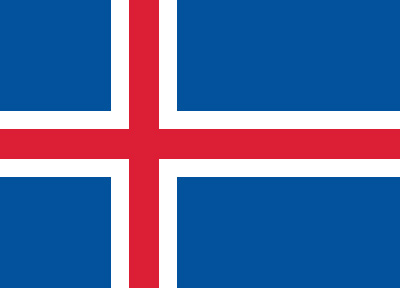 |
A rather rainy look at the current tourist hotspot, with an amazing guide and driver. |
Readers Note:
The names of Iceland locations are, well, pretty difficult to pronounce. The language is a mixture of Norse, Danish and Swedish, and supposedly one of the most difficult to learn. So if you want an exercise in tongue twisting, have at it.
The video files are of low resolution and are in AVI format. They must be downloaded and then played. I could have embedded them, but then you have to "Allow Blocked Content" and they play continuously, which I find dreadfully annoying. This way, if you want a video clip, download and play. Otherwise. skip it.
September 17/18
We boarded our Iceland air flight to Reykjavik around 11 PM local, and much to our delight, found a sparsely loaded cabin. In fact, each passenger had an entire row to themselves. When was the last time THAT happened. So it was a good excuse to sleep the flight away. We found out later that Icelandair hauls a great deal of cargo, and we may have just lucked out in the weight and balance department. It was an uneventful flight and we landed on time at Keflavik, which is out on the peninsula tip, about a half hour ride from Reykjavik. The weather was grey with rain. We did not know that this was going to be the norm for pretty much the entire trip.
Our
friends on the Seattle flight arrived about the same time, so we all
hooked up and after a half hour ride found ourselves in downtown
Reykjavik. Our first
impression of the country was a barren, treeless landscape.
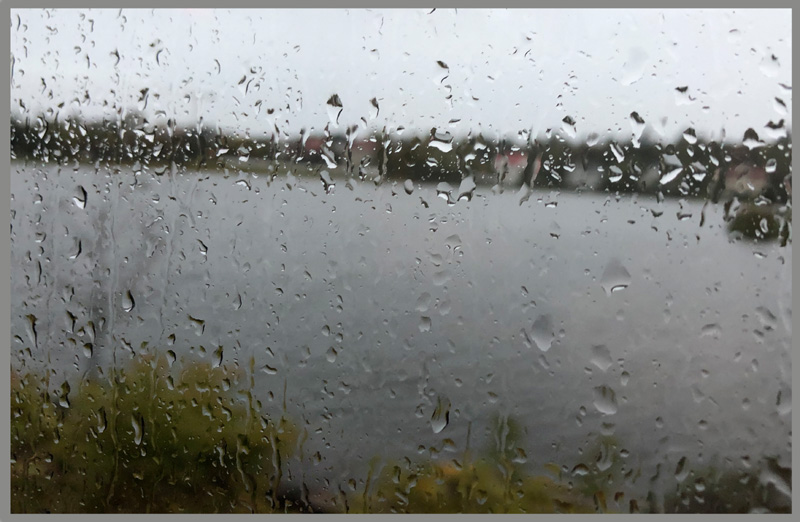
An initial disclaimer is due. I said the weather was grey, with rain. The photos that you are going to see on this day, were all shot the day returned to depart. THAT day dawned sunny and bright.
So we redid the city tour and walk, just to capture some better images.

So here we are in Iceland.

At first glance, the national bird of Iceland seems to be the construction crane. Actually, it's the Raven, but that knowledge would come later.
At the hotel, we were greeted by Kristen, who would turn out to be a simply fabulous tour guide.

First on the agenda, a city tour with the delightful Tomas who was a very humorous fellow and had a great command of American English due to his Chicago father. I learned that all over Iceland there are basalt columns, created by geothermal activity. These two are located close to the hotel as a sort of symbol of the land. They are flanked by two geothermal pipes, which were quite warm to the touch.
Then it was a short walk to the city square for a brief history of the island. Tradition holds that the place was discovered in early 800 AD by farmer Ingolfor Arnarson. He was escaping strife in what is now Denmark. Old Ingolfor could not take his house, but in order to maintain tradition took two big logs which were part of the foundation. The house had been in the family for generations and the foundation logs would carry forward that tradition. He came across Iceland, and dumped the logs in the water, thinking that the gods would show him the way. They floated into Reykjavik Bay, which literally means “Smokey Bay” – Reykja = smoky, Vik = bay. There wasn’t much to burn, so the smoke was probably steam from the thermal pools of water around the area. The whole place was settled by 874. How do people know this exact date? It is because every person who came into the country was recorded in The Book of Settlements. This has been a huge trove of historical information.
 Iceland
has the world’s oldest parliament.
The government seat is quite small.
The crown and the numeral 9 represent Christian the 9th,
the Danish king who got things started.
The four symbols – dragon, bear, pig and eagle are the guardians
of the island.
Iceland
has the world’s oldest parliament.
The government seat is quite small.
The crown and the numeral 9 represent Christian the 9th,
the Danish king who got things started.
The four symbols – dragon, bear, pig and eagle are the guardians
of the island.

This church is the oldest church in the country.
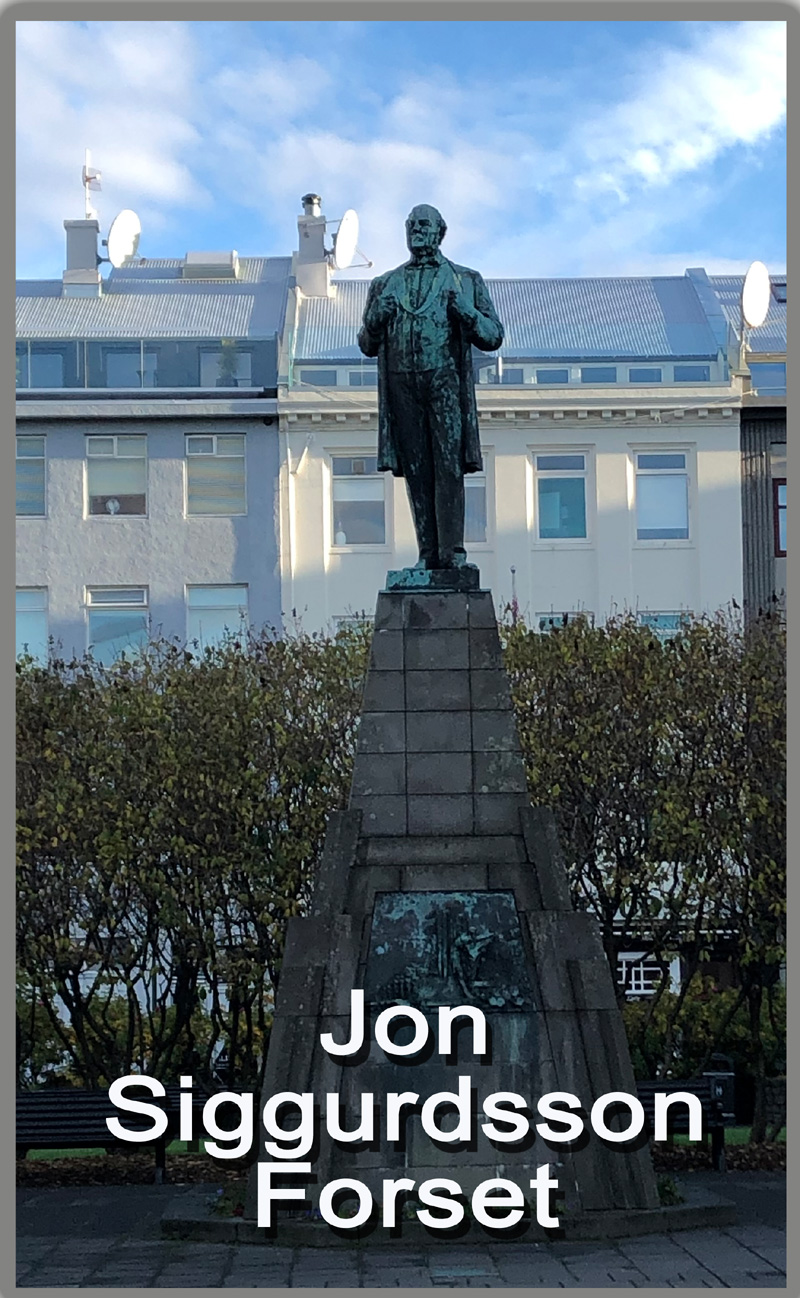
Iceland took (gained) it’s independence from Denmark in 1944 with
the efforts of Jon Siggurdsson Forset.
The Danes were Axis powers, while Iceland occupied by the Allies.
As there was no communication between Iceland and (German
occupied) Denmark, the Iceland’s figured they could just declare
independence. Which they
did in 1944. Once the war
ended, the people notified Denmark of what they had done.
Denmark’s response was pretty noncommittal.
They just said, “Well, OK.
Guess that will work.”
And that was that.
Lunch was beef soup and good bread at a local pub, followed by a nap.
Honestly, time zone changes are not as swift as they used to be
when I was younger. The
evening ended with a welcome dinner at a nearby hotel buffet.
September 19
Rain, rain, rain. Grey and rain. For some reason, we missed the alarm so a hurried breakfast was followed by a dash for the bus. Today we did the Golden Circle, so named because this is the easiest trip for visitors to see interesting things in the shortest time. It basically covers a circular route around the south eastern part of the island.
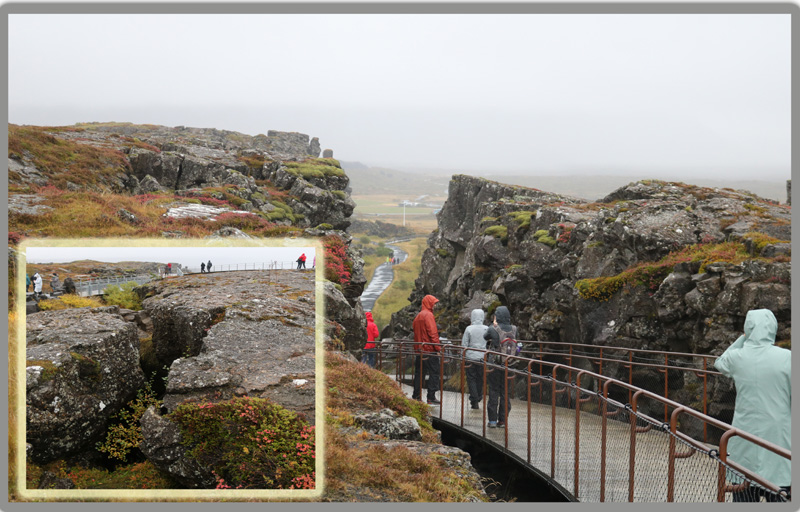
We climbed into the lava encrusted hills to our first stop, the Thingvellir National Park which is a UNESCO Heritage site. Iceland straddles the North American and European tectonic plates and the park is the place to see prime examples of the rifts and valleys that occur as a result of the plate movement
 The park is also the site of the first national meeting of all
the Icelandic clans to establish unification to the various settlements.
The park is also the site of the first national meeting of all
the Icelandic clans to establish unification to the various settlements.
During the Settlement Period, many people from Norway settled in Iceland. They all had their own customs, leaders and religions. This was plainly unsustainable, with violence and dissention between the groups. District assemblies began to form, but most of the power was concentrated around Reykjavik and Ingolfur’s descendants. There was resentment afoot, and a push for a general assembly was raised. As luck would have it, a man living near Reykjavik named Grimur Geitskor was convicted of murder. As a result, his major land holdings were moved into public domain. The land was sheltered and accessible by all Icelanders. In 930 AD this land was chosen as a meeting place for over thirty clan chiefs. It took some of the representatives seventeen days to get to this place. The encampment site was well chosen, because there was a relatively flat plain for camping, and a raised stone “pulpit” for announcements and proclamations. The result of the first meeting was a common law and a commonwealth. In fact, it was the first modern day representative parliament in history. The meeting was such a success that people returned on an annual basis. The institution, called the Altingi, provided a place to adjudicate disputes, punish criminals and share news. It was here that the old Norse pagan belief system was abandoned in favor a Christianity around 1000 AD.
 The tectonic rift was quite evident here, and the barren lava and
craggy up thrust ridges are starkly beautiful.
The rather sparse vegetation was showing some autumnal color, but
as for trees and brush, there really isn’t much.
Apparently Iceland was covered with trees and brush cover, but
the early human settlements deforested the island for housing and
heating purposes (before they discovered the geothermal angle.)
The people are attempting to reforest, so every once in a while
we would see groves and splotches of trees and brush.
There are many lakes, and the end of the walk was a small
waterfall, one of many found in the island.
The tectonic rift was quite evident here, and the barren lava and
craggy up thrust ridges are starkly beautiful.
The rather sparse vegetation was showing some autumnal color, but
as for trees and brush, there really isn’t much.
Apparently Iceland was covered with trees and brush cover, but
the early human settlements deforested the island for housing and
heating purposes (before they discovered the geothermal angle.)
The people are attempting to reforest, so every once in a while
we would see groves and splotches of trees and brush.
There are many lakes, and the end of the walk was a small
waterfall, one of many found in the island.
 Our next stop was
the Efstidalur dairy farm.
This farm has been in operation for seven generations, and is
completely automated.
Our next stop was
the Efstidalur dairy farm.
This farm has been in operation for seven generations, and is
completely automated.
We tried skyr, which is a yogurt like food, which some of our group had heard of – but I had not. It can be used in place of sour cream, is loaded with probiotics and calcium, and is a lighter version of cream cheese for use in cheesecakes, or just eaten at meals like yogurt. It’s pretty good and improved with berries to liven it up.

We also were served whey, which is the liquid remaining after milk has been curdled or pressed out of cheese. While not to my liking, it is touted as a preservative and a health drink. In fact, much of the food storage in old days was in whey. After local ice cream, yum, we headed to Geysir Park.

There we watched the Strokkur and Litli geysers, which were apparently the first geysers described in printed literature and the first known to modern Europeans. While not as large (or as regular) as Old Faithful of Yellowstone fame, they are still impressive and spout on a much quicker timeline. For a quick look at a minor eruption, click here.
 Our next stop was the Gullfoss, the Golden Waterfall.
It is pretty impressive, although there are 104 steps down, and
of course, 104 steps up. It was
quite windy, and for a quick peek at roaring water, click
here. Beware the wind
noise.
Our next stop was the Gullfoss, the Golden Waterfall.
It is pretty impressive, although there are 104 steps down, and
of course, 104 steps up. It was
quite windy, and for a quick peek at roaring water, click
here. Beware the wind
noise.

Our final stop of the day was a hydroponic tomato greenhouse. Now you are probably having the same initial reaction I had. Oh boy, so what. But this proved to pretty interesting. It consisted of around 5,000 m2 of suspended vines, producing about a ton of tomatoes per week. It is all heated by thermal water.
We got a little talk on the output - which was enough to make us wonder whether every subsequent tomato we were served came from here. We had tomato soup and yummy bread, as well as a sample of tomato beer. The first sip was OK, but for me, it did not improve with time.

Included was a horse show, with Icelandic horses (NOT ponies!) which are smaller and sturdier than the horses we know. This native breed is capable of five different gaits, (walk, trot, gallop, tölt, pace) all of which were demonstrated. For another short clip, click here.
On the way back to Reykjavik I took my usual nap. In fact, this trait will earn me the nickname “sleepy” from our northern driver.
We had
dinner in a local bar which was a fun time.
One of the things I really enjoy on these tours is getting into
local haunts and just hanging out with the locals.
Today we walked about six miles so should sleep well tonight.
The three pillars of the
Icelandic economy are fishing, tourism, and the sale of electricity to
heavy industrial users. As
an example of the latter, there is a lot of aluminum smelting, which is
a big electricity consumer.
It is more cost effective to ship bauxite from Australia and Brazil to
Iceland to be smelted. The
energy comes from geothermal and hydro.
The national population is around 340,000, but there are around 800,000
sheep. So sheep and their
wool are probably an economic factor as well.
September 20
Rain, rain, and more rain. All night long it rained. And it was raining as we left for the domestic airport which is located in the center of the city.

After a 45 minute hop to the northwest, we found ourselves in the fishing village of Akureyri, located right at the edge of the Arctic Circle.
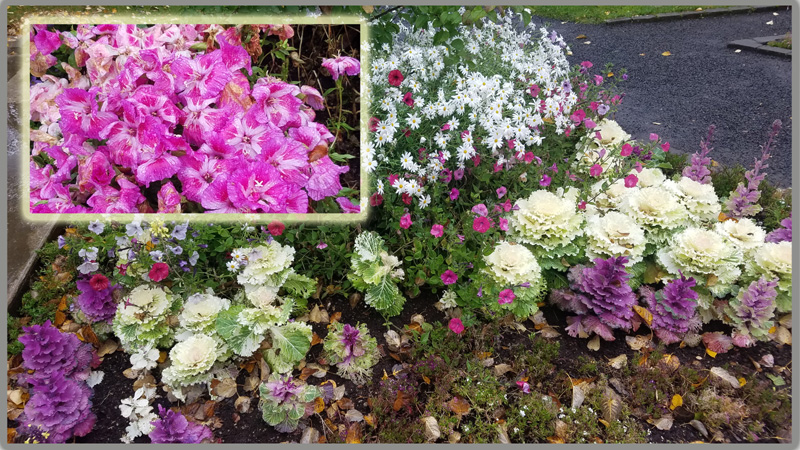
Our first stop was a botanical garden which was rather odd to find this far north. It was pretty, despite the rain. All the horticulturalists out there can identify the flowers and plans. That is not the case for me!

We headed into the small downtown after parking next to a modern convention center.
The town had many restored old wood houses, and was quite charming.
We walked into the city center and had a quick lunch at an Illy. I had a late breakfast with enough bacon to satisfy the entire state of Iowa. Note the Akureyri heart shaped stop lights. They were made to cheer people up during the 2008 economic crash and have now become rather a hallmark of the town.

A look at the harbor in Akureyri.
 Then it was
on over a mountain pass to see the Godafoss waterfall.
The land on the way is pretty open and the result of old lava
flows. So there are some
trees, particularly in the mountain slopes, but these have been planted
as a part of the reforestation project.
Then it was
on over a mountain pass to see the Godafoss waterfall.
The land on the way is pretty open and the result of old lava
flows. So there are some
trees, particularly in the mountain slopes, but these have been planted
as a part of the reforestation project.
It is autumn, so there is some Fall color, not only in the trees, but in the heather and ground cover as well.

The grey day certainly muted the whole look.
 The waterfall was really quite lovely, in a horseshoe shape.
The river was raging, and you could stand on a small footbridge
and see the rushing water.
The waterfall was really quite lovely, in a horseshoe shape.
The river was raging, and you could stand on a small footbridge
and see the rushing water.
It is a good thing that we were used to stairs, as there were a LOT of stairs down to the viewing platform, and subsequently, back up again.

This is probably the Christmas card photo. See. We really were there!
For a clip of the Godafoss in action, click here.
On then to a turf house, which is how a lot of Icelander’s lived in the early 19th & 20th centuries. The people didn’t have wood, so what lumber was available came from driftwood, some from as far away as Siberia

Sod or turf was cut and put over the logs. As these houses evolved, gables were added to make them appear more “European” with living quarters on the second floor and cooking, food processing and animal stables on the ground level. As cow will generate about 8 times the heat of a human, packing in a few on the ground level would be a good heat source. Cooking and minimal heating was done with dried animal dung, and later, some coal. Snooty, visiting European dignitaries said that the Icelander’s lived in the ground like rabbits, so living in these places became a mark of shame. As late as the early 20th century there were some 70,000 of these, but by the late 1940s most were gone. The one we visited is a preservation site.
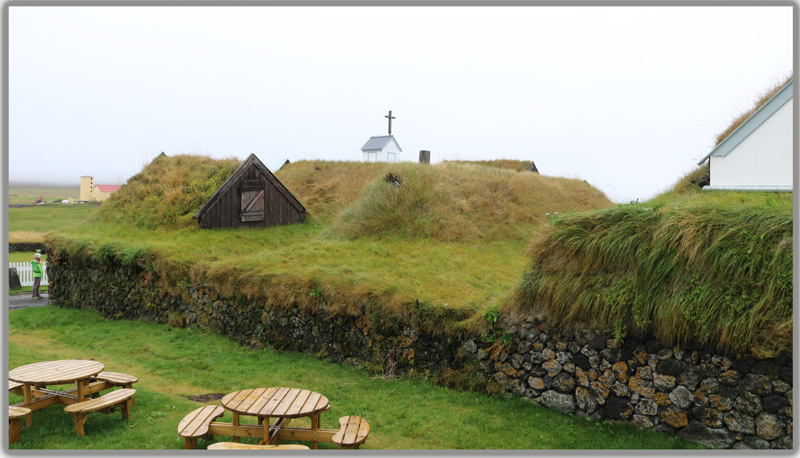 Today there are around 70 of them left.
This one was built in 1865 as a preacher’s house.
Some of the rooms were pretty sparse, but a couple were done up
with wallpaper and ceiling lights.
Today there are around 70 of them left.
This one was built in 1865 as a preacher’s house.
Some of the rooms were pretty sparse, but a couple were done up
with wallpaper and ceiling lights.
 The nearby church, built also in 1865, was still in use.
The first owner had 8 children, four of whom died after being
exposed to measles. One big
problem early on was the lack of grain.
The growing conditions here are not conducive to growing grains,
so in 1900 more grain was imported than today.
Bread was an issue.
The downstairs was pretty much ruled by whomever doled out the food.
Everyone had a ration box, which was filled for a two or three
day supply. There apparently
wasn’t any communal sit down for dining.
You went to a corner and ate when you were hungry.
The nearby church, built also in 1865, was still in use.
The first owner had 8 children, four of whom died after being
exposed to measles. One big
problem early on was the lack of grain.
The growing conditions here are not conducive to growing grains,
so in 1900 more grain was imported than today.
Bread was an issue.
The downstairs was pretty much ruled by whomever doled out the food.
Everyone had a ration box, which was filled for a two or three
day supply. There apparently
wasn’t any communal sit down for dining.
You went to a corner and ate when you were hungry.
We headed out to our home for the next three nights, the Hotel Raudaskrida, a lovely country inn near Pingeyjarsveit. The rooms are comfy, the geothermal water is hot, and the food is excellent. As it is the end of the season, we seem to have the place to ourselves. A rowdy time was had at dinner. We have met some really nice people, in addition to reconnecting with our Yakima friends.
September 21
 For a change, it was not raining.
We can actually see across the valley.
It is quite bucolic.
We had a lovely breakfast, and hopped on the bus for a trip up the coast.
Of course we had a few stops to admire the cliffs and vast emptiness of
the sea.
For a change, it was not raining.
We can actually see across the valley.
It is quite bucolic.
We had a lovely breakfast, and hopped on the bus for a trip up the coast.
Of course we had a few stops to admire the cliffs and vast emptiness of
the sea.
 Our first stop was at Vatnajökull National Park where we were treated to great autumn
colors and lots of water. We
stopped in Asbyrgi Canyon which was carved by a glacial flood.
According to mythology, Iceland was so named by Floki, the guy
with the ravens, who sailed over from Norway or Denmark, spent the
winter on the north coast, and experienced a severe winter.
Folklore also has it that this horseshoe canyon was created by
Odin’s eight legged horse, Sleipnir.
He accidentally hit the ground with a hoof and created the
canyon. This area is again
astride the American and European tectonic plates so we got to see more
land rifts.
Our first stop was at Vatnajökull National Park where we were treated to great autumn
colors and lots of water. We
stopped in Asbyrgi Canyon which was carved by a glacial flood.
According to mythology, Iceland was so named by Floki, the guy
with the ravens, who sailed over from Norway or Denmark, spent the
winter on the north coast, and experienced a severe winter.
Folklore also has it that this horseshoe canyon was created by
Odin’s eight legged horse, Sleipnir.
He accidentally hit the ground with a hoof and created the
canyon. This area is again
astride the American and European tectonic plates so we got to see more
land rifts.

The end of the walk was a beautiful still pond. The water was glass smooth, and clear as can be. There were plenty of waterfalls feeding this. We did not see any fish. Iceland is apparently well known for it's trout fishing.
 Then
we headed to Husavik, a small village on what is known as Shaky Bay, due
to the many slight tremblers the island has.
It is the center for whale watching, and even though it has a
population of only 2,430 had a lovely church, old wood houses, and great
restaurants. We had lunch in
a small local bakery, which had delicious pastry.
Then
we headed to Husavik, a small village on what is known as Shaky Bay, due
to the many slight tremblers the island has.
It is the center for whale watching, and even though it has a
population of only 2,430 had a lovely church, old wood houses, and great
restaurants. We had lunch in
a small local bakery, which had delicious pastry.
 We visited the whale museum, with whale skeletons and the history
of whaling. It was nicely
done. For the record,
Iceland no longer hunts whales.
These animals are huge. In fact, until you see the size of the
skeletons, you really have no idea.
We visited the whale museum, with whale skeletons and the history
of whaling. It was nicely
done. For the record,
Iceland no longer hunts whales.
These animals are huge. In fact, until you see the size of the
skeletons, you really have no idea.

The final stop of the day was boarding a whale watching boat. The RIB boat was not operational so we were on a beautiful antique wooden scooner. We had to wear thermal coveralls, and by the time we were done, were thankful to have had them, as it was cold on the water. Barb here, is snug as can be in her very attractive thermal suit.
 We did see some whales of various types..
They weren’t exactly trained to come to the surface, so we saw
sounding and flipper movement.
The final exposure was a pod of Minke Whales, which the boat
captain said was quite rare.
We did see some whales of various types..
They weren’t exactly trained to come to the surface, so we saw
sounding and flipper movement.
The final exposure was a pod of Minke Whales, which the boat
captain said was quite rare.
 Dinner was at a local restaurant, with arctic char again on the menu.
It turns out that this is a fresh water fish which I, having
little knowledge of fishing, did not know.
Dinner was at a local restaurant, with arctic char again on the menu.
It turns out that this is a fresh water fish which I, having
little knowledge of fishing, did not know.
This would be a great place to escape the world.
Barb talked to one of the boat crew who was from Switzerland and
was doing exactly that. He
built wood boats, and was a happy camper.
Back to our country inn, followed by a quick nightcap and bed.
Tomorrow is going to be a long day, with five stops.
September 22
We missed a faint showing of the Northern Lights last night. We just slept through it. Boo. There was apparently a slight break in the clouds. Apparently these things are not as easy to spot as one is lead to believe. Mostly they are just a faint ripple in the sky. We missed it.
 The day
started with a visit to Skutustadagigar.
This is an area of volcanic lakes.
The entire island experiences lots of volcanic activity, and we
see steam plumes, hot water, land rifts, and lots of areas that are
simply volcanic fields, so flat and barren due to an abundance of ground
sulfuric acid.
The day
started with a visit to Skutustadagigar.
This is an area of volcanic lakes.
The entire island experiences lots of volcanic activity, and we
see steam plumes, hot water, land rifts, and lots of areas that are
simply volcanic fields, so flat and barren due to an abundance of ground
sulfuric acid.

There are some amazing rock formations. We could see two big lakes, Alftafogur and Stakholstjorn. And sheep.

Then on to Dimmuborgir an area where the earth’s crust was quite thin. The volcanic chimneys thrust up close together, but then the earths crust between them collapsed, and caused the dried magna and left really wonderful rock shapes. It looks quite prehistoric, and is the site where some of the “Game of Thrones” television series was shot.
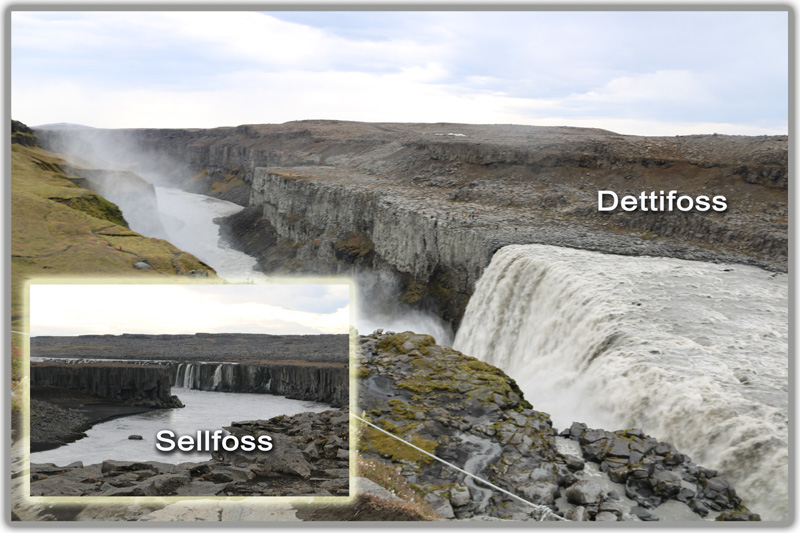 Next stop was the Selfoss and Dettifoss, two waterfalls on the
Jokulsa a Fjollum River, which flows north to a bay on the Arctic Sea.
The Dettifoss was pretty large due to the narrow canyon, while
the Selfoss upper falls were more
fanned out. Barb and I made
it to the lower falls, after a walk of about 2 km.
The volume is around 2000 liters per second and is quite a sight.
For a clip of the falls in action, click
here.
Next stop was the Selfoss and Dettifoss, two waterfalls on the
Jokulsa a Fjollum River, which flows north to a bay on the Arctic Sea.
The Dettifoss was pretty large due to the narrow canyon, while
the Selfoss upper falls were more
fanned out. Barb and I made
it to the lower falls, after a walk of about 2 km.
The volume is around 2000 liters per second and is quite a sight.
For a clip of the falls in action, click
here.

We had to navigate a rock field left by a glacial flood, with lots of large boulders just tossed around. The people on the right of the image will give you some idea as to the scale.
 Then it was on to the Namafjall geothermal fields, which looked a
lot like Yellowstone, although not as colorful.
Then it was on to the Namafjall geothermal fields, which looked a
lot like Yellowstone, although not as colorful.
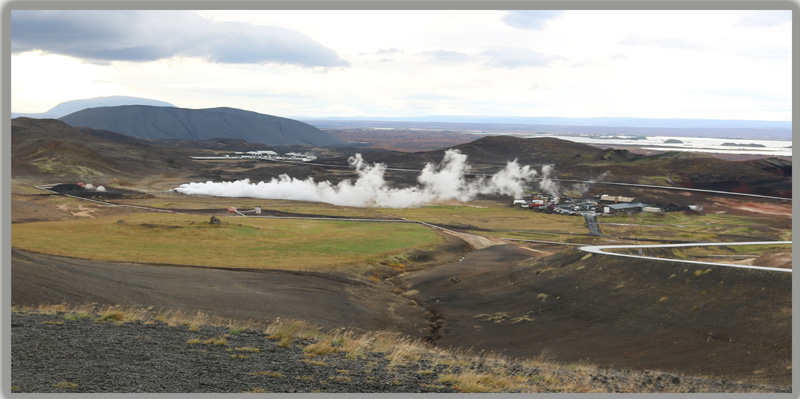
Iceland is well known for it's high use of geothermal activity to produce electricity. Have you ever wondered what a geothermal plant looks like? It isn't very impressive, as it just uses hot water to create steam that in turn drives turbines. The most exciting look is the waste steam, and of course, the waste hot water.
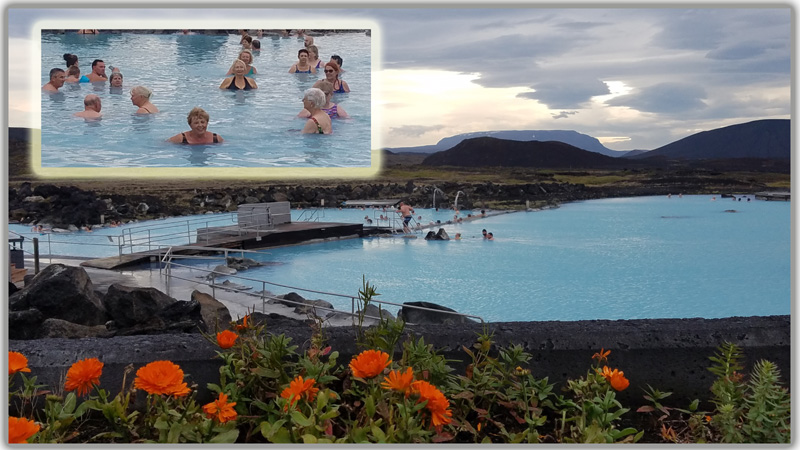 Our final stop was the relaxing part of the day at the Myvatn
Nature Baths. The water is
milky, due to the high silica content and as expected, quite warm.
The trip from changing rooms to water was a tad nippy.
We lounged around there for a bit, had a coffee and then headed back to the
hotel. Of the two baths we
visited – this and the Blue Lagoon – we found this to be much more
relaxing, as it was out of the way of the tourist hordes and a tad more
rustic.
Our final stop was the relaxing part of the day at the Myvatn
Nature Baths. The water is
milky, due to the high silica content and as expected, quite warm.
The trip from changing rooms to water was a tad nippy.
We lounged around there for a bit, had a coffee and then headed back to the
hotel. Of the two baths we
visited – this and the Blue Lagoon – we found this to be much more
relaxing, as it was out of the way of the tourist hordes and a tad more
rustic.
 On our return to the
hotel, we went through some barren stretches, which the country is
trying to reclaim with Alaskan Lupine.
Drinks await.
On our return to the
hotel, we went through some barren stretches, which the country is
trying to reclaim with Alaskan Lupine.
Drinks await.
We hope
it clears off but we were again disappointed.
I tried to alleviate last night’s missed Northern Lights
opportunity but I had no luck.
I think I was up every hour, but a) there was only one hole in
the clouds early in the evening, and b) there was NO magnetic activity.
These things apparently aren’t as regular as clockwork, and tend
to be more hit or miss. In
fact, there is a phone app that predicts locations and activity
probabilities.
September 23
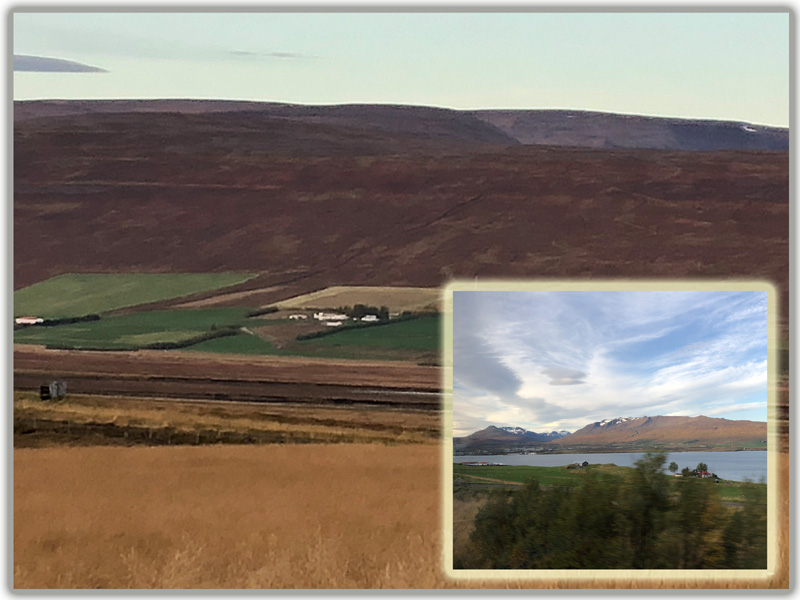 We
left out little lovely country hotel and our hosts, Begga and Halli, and
started on our “Day at Sea.”
For the uninitiated, that is a day where you really have nothing planned
and go from one port to the next.
Iceland has been a contrast between jagged volcanic rock ridges,
old mountains, and deep wide valleys.
We
left out little lovely country hotel and our hosts, Begga and Halli, and
started on our “Day at Sea.”
For the uninitiated, that is a day where you really have nothing planned
and go from one port to the next.
Iceland has been a contrast between jagged volcanic rock ridges,
old mountains, and deep wide valleys.
 Our
first stop was at Vidimyrarkirkja, a small turf church built in 1834.
Apparently it was constructed as a tribute to the
Asbirningar
clan which was a warrior political dynasty of the time.
One of the members was a poet of some renown, and
wrote a beautiful
poem about dying in battle, which was the honorable thing to do.
As a turf building, it is a little different from the place we
visited the other day, and was quite lovely.
Our
first stop was at Vidimyrarkirkja, a small turf church built in 1834.
Apparently it was constructed as a tribute to the
Asbirningar
clan which was a warrior political dynasty of the time.
One of the members was a poet of some renown, and
wrote a beautiful
poem about dying in battle, which was the honorable thing to do.
As a turf building, it is a little different from the place we
visited the other day, and was quite lovely.
Incidentally, I had always been told that Iceland was so named because the people wanted the Vikings to stay away, and Greenland was so named because people wanted to lure the marauders to the ice. Au contraire. Iceland was always – Iceland, and was so named because the early north coast settlers experienced severe Arctic winter ice packs . Eric the Red, famous Viking explorer, was actually from Iceland. He sailed west, and first discovered Greenland. Because the climate was a bit more temperate at the time he found it, he attempted to lure more people to come to the land. So the whole thing was a marketing scheme. He named it Greenland just to attract new immigrants.
 Iceland
suffered along with the rest of Europe through famine, the Plague Years,
and all that. Iceland
implemented a sort of bondage system where by existing farms could keep
tenants in bondage for a year.
At that point, the workers could change farms.
Eventually the population wised up that this scheme was not
working and people moved to the coastal areas and started the fishing
industry and supporting industries.
Iceland
suffered along with the rest of Europe through famine, the Plague Years,
and all that. Iceland
implemented a sort of bondage system where by existing farms could keep
tenants in bondage for a year.
At that point, the workers could change farms.
Eventually the population wised up that this scheme was not
working and people moved to the coastal areas and started the fishing
industry and supporting industries.

This would be a great time to toss in a photo of our driver, and his faithful steed. He was humorous, helpful, and a very personable gentleman. Barb was ecstatic that he was able to tune the Packer game and watch it live, on the bus driven Wi-Fi.
 After a delicious
lunch in a small fishing village, we stopped at a wool factory, where we
saw how much of the blankets and sweaters are made.
Sadly, it is all pretty much machine produced, although the
knitting machines are pretty complex.
It always makes me wonder what engineering genius thought this
up. Just load the yarn, set
up the program, and walk away.
After a delicious
lunch in a small fishing village, we stopped at a wool factory, where we
saw how much of the blankets and sweaters are made.
Sadly, it is all pretty much machine produced, although the
knitting machines are pretty complex.
It always makes me wonder what engineering genius thought this
up. Just load the yarn, set
up the program, and walk away.
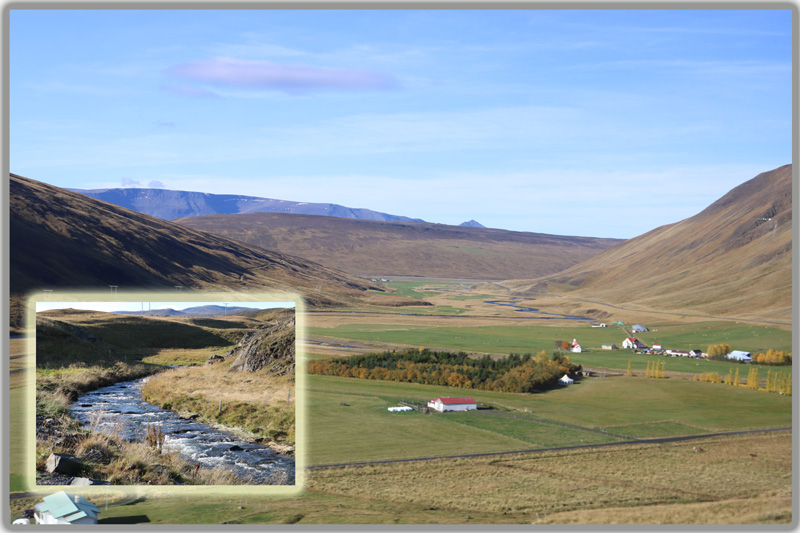 A
map of Iceland shows a lot of fjords and inlet bays.
To me it looks a little like a crab with a hat. At the west end
are two long arms.
A
map of Iceland shows a lot of fjords and inlet bays.
To me it looks a little like a crab with a hat. At the west end
are two long arms.
We are headed to the northern arm and the town of Stykkisholmur (Sticky Sticky.) To get there we took a summer shortcut which routed us on potholed secondary roads with many one lane bridges. It was a bumpy afternoon ride but very scenic.

One of the interesting items along the way was this sheep pen. The sheep are all tagged for ownership, but allowed to pretty much graze wherever they want. So periodically the animals are all herded into pens like this where they are sorted into their individual owners.

Why are we looking at Icelandic horses? I just liked the photos. That's why.
Stykkisholmur has a natural harbor, commercial fishing, and is a haven for summer homes for people from Reykjavik as it is only about 2 ½ hrs. north. The bay also has a lot of islands, so it can be quite a summer playground. We are lodged here for two nights. Dinner was at the hotel and I’m blowing off the local currency on drinks. A thousand kroner note may look like a lot, but doesn’t go very far. I talked to our driver, Gretar, who is quite interesting. He and Kristin, our guide, have been first class, very knowledgeable and fun to be with. BTW, guides and drivers refer to OAT Travel as “Old American Tourists.”
September 24
Once again, we were greeted with more rain. Due to the deteriorating weather, the trip to the glacier was cancelled as it would have been too dangerous.
By the way, did I mention that the water is all good to drink? Well, it is. The hot is pumped from underground with no heating necessary and is a little sulfurous, but the cold is the best I’ve tasted. Or not tasted. Any hoo.

Today we started driving down to the lower coast of the upper peninsula.
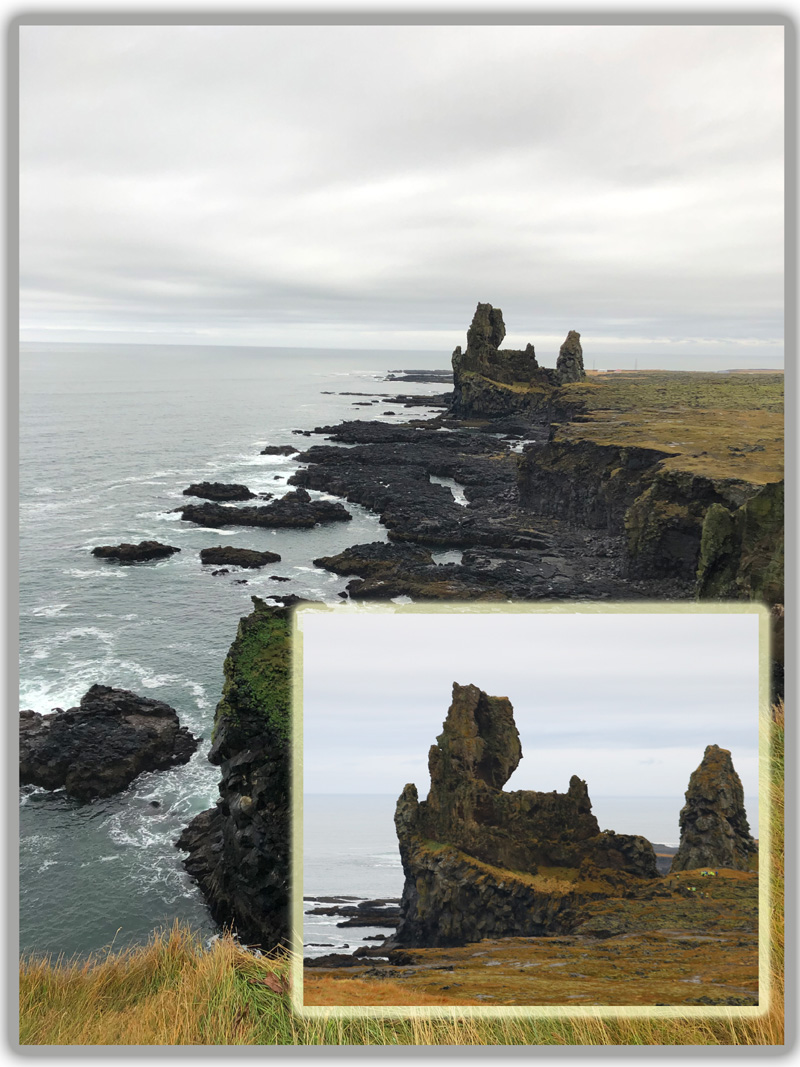
Our first stop was Skyringar National Park to see the lava cliffs and The Giants, at Svalpufa. These are a couple of basalt lava columns set on steep lava cliffs. These chimneys can be found all over the place, and are the result of magna up thrusts that spew, and then cool in place. Much of this is lava field, and is not something you would want to hike through. On the plus side, there is no shortage of gravel for the roads. The whole place is quite lonely, as it is vast openness. There are just these huge expanses of lava fields, grazing sheep and the ocean. It will be punctuated every once in a while by a small farm. So rocks, sheep, horses, and waterfalls pretty much define the whole area.
 The primary
thing this morning was the Vatnshellir Cave.
The pointed metal "cap" is the opening that covers a spiral staircase
that takes you down into the cave.
This is a lava tube and is about 35 meters underground.
It was – a cave.
The primary
thing this morning was the Vatnshellir Cave.
The pointed metal "cap" is the opening that covers a spiral staircase
that takes you down into the cave.
This is a lava tube and is about 35 meters underground.
It was – a cave.

There were two levels, connected by spiral staircases that went down from the surface and then from level one to two. Level two was about 12 meters down, so think four stories. As it is a lava field, there are no traditional stalactites or stalagmites. The water and rock has no mineral content. So the whole thing was just rough walking, pitch black except for our helmet lights, and constant dripping. Still it was somewhat interesting. The only sign of any habitation were the old, old bones of an arctic fox.
We stopped for lunch, where everyone bailed out on the lunch buffet and had a burger.

Then there was a short walk to see the troll lighthouse, and a pleasant walk along the steep cliffs to see - well, more basalt cliffs long the shore.
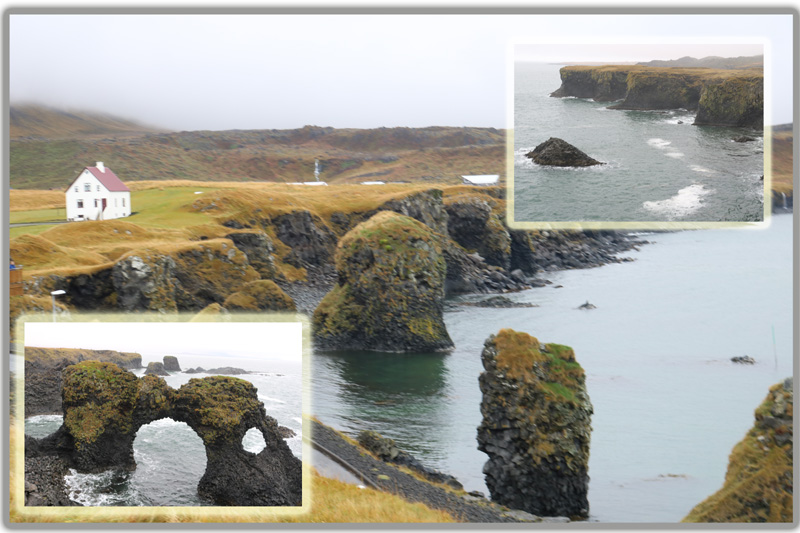
Just to toss in some levity, I got Kristin to sing “Wheels on the Bus” in Icelandic. Which you can view here. She has a two and half year old grandson, and so was quite familiar with the song. We stopped at the Black Beach at Djupalonssandur which was highlighted by more lava fields, and more cliffs along the shore. The beach sand consisted of smooth tiny black stones.
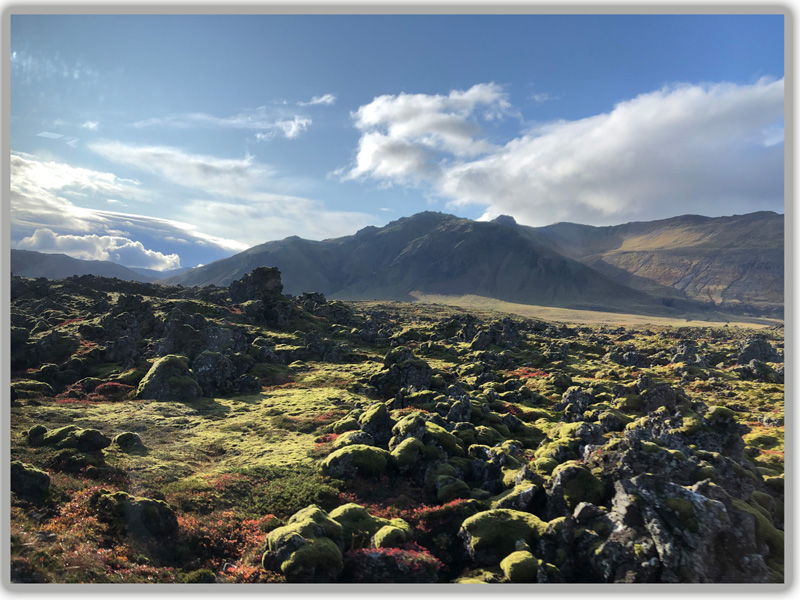
About midafternoon, once we got to the top of the peninsula, the sun broke though for a sunny look at the tumbled landscape.
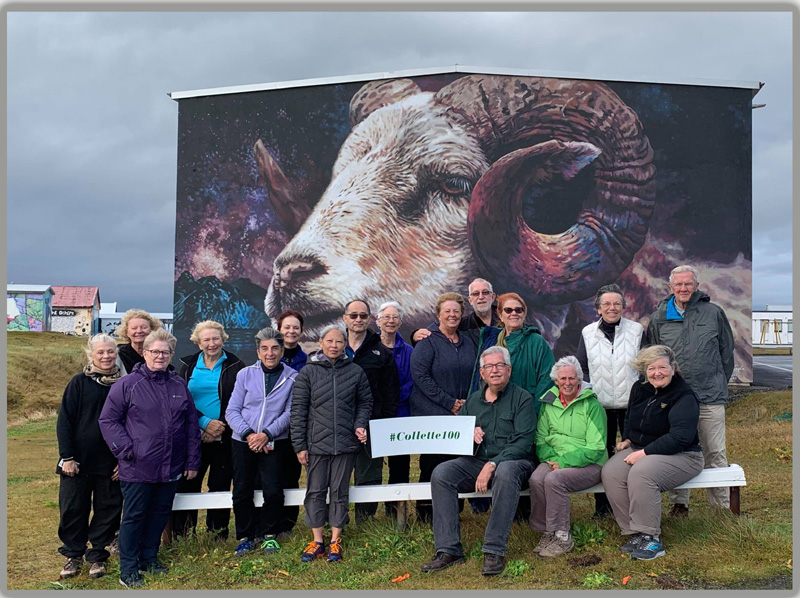 We
stopped at a small town which is trying to make a name for itself as an
artists colony. The name escapes me, but we did have time to stop
for a group photo beside one of the colorfully painted buildings.
We
stopped at a small town which is trying to make a name for itself as an
artists colony. The name escapes me, but we did have time to stop
for a group photo beside one of the colorfully painted buildings.

We saw what is supposed to be the most photographed mountain in Iceland, Table Mountain.
 Then it was on to
the shark processing plant.
Sharks are no longer hunted. The
only sharks this place takes are accidental catches of Greenland shark
which can get up to 7 meters in length and weight as much as 1,400 kilos
(3,100 lbs.) The founder of
this processing plant used to hunt these things in a 9 meter boat.
Yikes! The sharks are
deep swimmers, up to 2,000 meters, and prefer cold water.
The teeth are serrated in opposing rows.
So food is literally sawed into digestible chunks.
Shark meat is toxic to humans, as sharks have no kidneys.
The renal system runs the waste through the shark tissue to
create an natural antifreeze.
The meat can be made edible though.
The processing plant does all work by hand and generates about 3
tons of meat per year. The
processing is done like this.
The spine (which is not bone but cartilage) is removed, and the
meat is carved up into chunks roughly 12x6.
The stuff is then stacked in a wooden crate and set outside with a
large weight on the top.
This compresses the meat and drains out the water.
The weighting and drying allows bacteria within the meat to
ferment and turn the toxicity into ammonia.
This is done during the winter.
After three months the meat is removed and hung in a drying shed
for an additional few months.
Then it is good to eat.
The stuff is a big deal in Iceland and isn’t exported.
It has a strange taste.
It’s one of those things that you don’t have to like, and you
wouldn’t want to eat a lot of it.
Kristin said that it is so packed with protein and nutrients
that you couldn’t make a meal of it anyway.
Then it was on to
the shark processing plant.
Sharks are no longer hunted. The
only sharks this place takes are accidental catches of Greenland shark
which can get up to 7 meters in length and weight as much as 1,400 kilos
(3,100 lbs.) The founder of
this processing plant used to hunt these things in a 9 meter boat.
Yikes! The sharks are
deep swimmers, up to 2,000 meters, and prefer cold water.
The teeth are serrated in opposing rows.
So food is literally sawed into digestible chunks.
Shark meat is toxic to humans, as sharks have no kidneys.
The renal system runs the waste through the shark tissue to
create an natural antifreeze.
The meat can be made edible though.
The processing plant does all work by hand and generates about 3
tons of meat per year. The
processing is done like this.
The spine (which is not bone but cartilage) is removed, and the
meat is carved up into chunks roughly 12x6.
The stuff is then stacked in a wooden crate and set outside with a
large weight on the top.
This compresses the meat and drains out the water.
The weighting and drying allows bacteria within the meat to
ferment and turn the toxicity into ammonia.
This is done during the winter.
After three months the meat is removed and hung in a drying shed
for an additional few months.
Then it is good to eat.
The stuff is a big deal in Iceland and isn’t exported.
It has a strange taste.
It’s one of those things that you don’t have to like, and you
wouldn’t want to eat a lot of it.
Kristin said that it is so packed with protein and nutrients
that you couldn’t make a meal of it anyway.
On the ride back to Stykkisholmur we heard that Iceland is number
one in the world in gender equality.
Birthrates, like most of the western world, are declining.
They have an infant family leave policy which is 3 months each
for father and mother, and an addition three that can be split.

This is an evening view across the harbor here in Stykkisholmur.
We split into two groups and pretty much took over the only two
good restaurants in town.
Things were loud, the food was fabulous, and the company was great.
Tomorrow we head back to Reykjavik.
September 25
 We
had a leisurely 9 AM start today, which allowed us a look at the
bucolic scene from our hotel parking lot. That is a very
interesting church.
We
had a leisurely 9 AM start today, which allowed us a look at the
bucolic scene from our hotel parking lot. That is a very
interesting church.
.
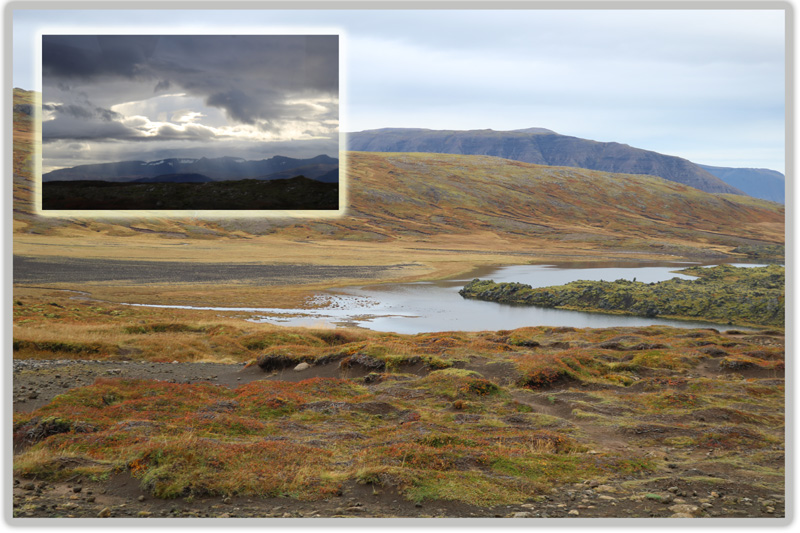
We headed back east on the peninsula, and then down toward the capitol. The scenery was the usual, with fields and stormy cloud formations

 Our first stop was
at the Settlement Center and Museum in Borgarnes.
Here we learned of the Saga of Egil, one of the big names in
early history. He was a
Viking, a poet, and is considered to be a very complicated and renown
character in Icelandic history.
I will not relate the entire history.
But briefly, the whole saga commences with Kveldulf and son
Skallagrim who end up in Iceland after problems with the Danish King
Harald the Fairhair. Skallagrim
has two sons, Egil and Thorolf Skallagrimsson, the latter being the
“fair haired boy” of the two.
Egil demonstrates a remarkable ability for composing stories, and
supposedly did so as early as age three.
Egil is a figure of varied character traits.
On one hand he is quick to anger and unusually cruel.
He is scheming, devious, and self centered.
On the opposite side, he is wise, loyal, respectful and a good
friend. The whole thing is a
look at the Scandinavian period of emigration to Iceland, where the long
harsh winters forced people to work together.
In his later years he is said to be a doting grandfather, and to
have buried a chest of gold in the marshes near where he lived.
People are still looking for that gold.
The Wikipedia version of the whole saga can be found at this
link.
https://en.wikipedia.org/wiki/Egil%27s_Saga.
I will say that
the displays in the museum were really something, with wood carved
figures in dioramas that depicted the major highlights in Egil’s tale.
We move from his killing a friend at age 8 to his final years
warming himself by the fire.
The artistically carved displays were a real treat to view.
Our first stop was
at the Settlement Center and Museum in Borgarnes.
Here we learned of the Saga of Egil, one of the big names in
early history. He was a
Viking, a poet, and is considered to be a very complicated and renown
character in Icelandic history.
I will not relate the entire history.
But briefly, the whole saga commences with Kveldulf and son
Skallagrim who end up in Iceland after problems with the Danish King
Harald the Fairhair. Skallagrim
has two sons, Egil and Thorolf Skallagrimsson, the latter being the
“fair haired boy” of the two.
Egil demonstrates a remarkable ability for composing stories, and
supposedly did so as early as age three.
Egil is a figure of varied character traits.
On one hand he is quick to anger and unusually cruel.
He is scheming, devious, and self centered.
On the opposite side, he is wise, loyal, respectful and a good
friend. The whole thing is a
look at the Scandinavian period of emigration to Iceland, where the long
harsh winters forced people to work together.
In his later years he is said to be a doting grandfather, and to
have buried a chest of gold in the marshes near where he lived.
People are still looking for that gold.
The Wikipedia version of the whole saga can be found at this
link.
https://en.wikipedia.org/wiki/Egil%27s_Saga.
I will say that
the displays in the museum were really something, with wood carved
figures in dioramas that depicted the major highlights in Egil’s tale.
We move from his killing a friend at age 8 to his final years
warming himself by the fire.
The artistically carved displays were a real treat to view.
 Our final stop was the Blue Lagoon which is halfway between the
airport and Reykjavik. Talk
about a money maker. The
thermal pools are a result of the wastewater discharged by the
geothermal power plant. The
whole thing – lockers, check in, drinks, etc. were automated via
wristband. It was nice to
visit, but we all liked the more native experience of the ones in
Myvatin. I forgot to
mention. When you order
dinner, upon completion, you don’t get a bill.
You have to remember what you had, go to the cashier, tell them
and then pay.
Our final stop was the Blue Lagoon which is halfway between the
airport and Reykjavik. Talk
about a money maker. The
thermal pools are a result of the wastewater discharged by the
geothermal power plant. The
whole thing – lockers, check in, drinks, etc. were automated via
wristband. It was nice to
visit, but we all liked the more native experience of the ones in
Myvatin. I forgot to
mention. When you order
dinner, upon completion, you don’t get a bill.
You have to remember what you had, go to the cashier, tell them
and then pay.
 After dinner
we took a short stroll down to the waterfront for a last evening look at
some of the sights. One is
the Harpa, the concert hall and convention center, designed by a Danish
– Icelandic architect. The exterior
is a show unto itself, with rippling lights and constantly changing
colors. For a seventeen second clip, click
here.
After dinner
we took a short stroll down to the waterfront for a last evening look at
some of the sights. One is
the Harpa, the concert hall and convention center, designed by a Danish
– Icelandic architect. The exterior
is a show unto itself, with rippling lights and constantly changing
colors. For a seventeen second clip, click
here.

A Viking boat gives testament to the Icelandic heritage.
As the skies darkened, we headed back to our downtown hotel, and
a goodbye dinner. We said
goodbye to Gretar, who, along with our fabulous guide Kristin, made this
trip so enjoyable. Really.
The two of them were loads of fun and really enhanced this brief
exploration of Iceland.
September 26
Of course it was sunny on our last day. It was a relaxed morning with last minute souvenir hunting.

The sights included proof that there is a touch of Ireland wherever you go.

For those in the Christmas spirit, an official letter from the Arctic Circle might be of interest. We bought a book on the Yule Lads. They have been cleaned up for modern times, but frankly, some of the old ones sounded a little scary.

We tried the Icelandic hot dog which was great. They have a lamb base, which sounds horrible, but was really tasty with a nice snap to the casing. It is something not to miss for you hot dog aficionados.
Unlike the inbound flight, the return was full, followed by a rough bus ride from O’Hare to Milwaukee. We were finally back to our own beds.
 So
our final look at Reykjavik. It is a lovely country, and we had a
wonderful time. It was a great trip, with a fun group of 17 people.
And again, our trip was greatly enhanced by our guide Kristen and driver
Gretar. We would recommend
seeing Iceland. The water
is good and the food is great. Public bathrooms are plentiful and spotless. English is
universally spoken. You
could easily rent a car to get around.
It is a lovely country.
So
our final look at Reykjavik. It is a lovely country, and we had a
wonderful time. It was a great trip, with a fun group of 17 people.
And again, our trip was greatly enhanced by our guide Kristen and driver
Gretar. We would recommend
seeing Iceland. The water
is good and the food is great. Public bathrooms are plentiful and spotless. English is
universally spoken. You
could easily rent a car to get around.
It is a lovely country.